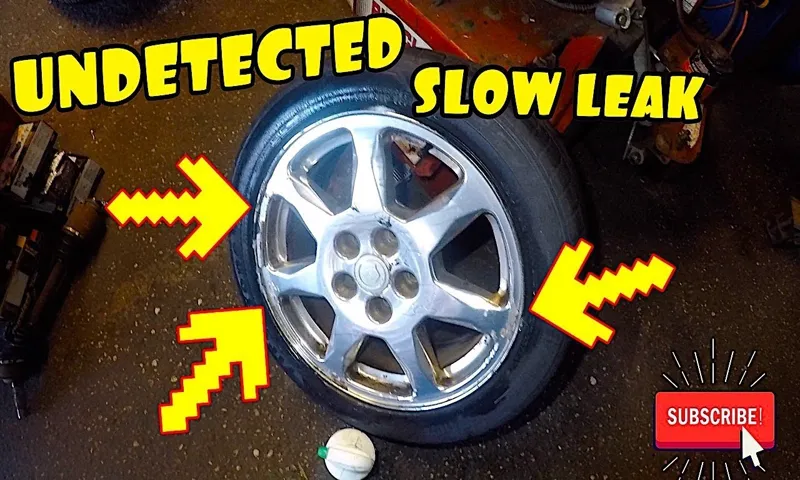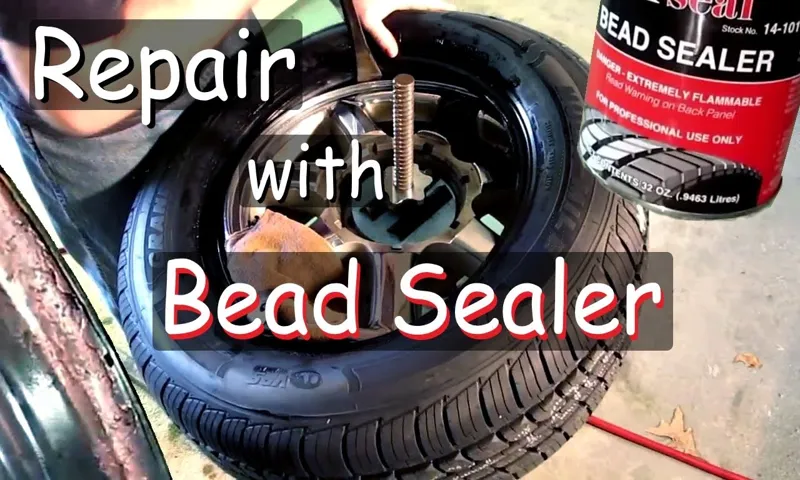When you are cruising down the highway and suddenly your car starts to feel wobbly, the cause might be a tire bead leak. It’s a common problem that often catches drivers off guard. In simple terms, a tire bead leak occurs when the tire bead, the edge of the tire that contacts the rim, fails to create a proper seal.
One little crack in the seal can cause air to escape, leaving you with an underinflated or flat tire. While a tire bead leak can seem like a minor inconvenience, ignoring the problem can be dangerous. Driving on a poorly inflated tire reduces your vehicle’s traction, making it difficult to control.
In addition, underinflated tires wear out quickly and can lead to tire failure. Therefore, it’s important to fix the issue as soon as possible. If you are wondering how to fix a tire bead leak, don’t worry.
It’s possible to do it yourself with the right tools and knowledge. This blog post will cover everything you need to know about fixing a tire bead leak, including the causes of the problem, how to diagnose it, and step-by-step instructions for repairing it. By the end of this post, you will have all the information necessary to get back on the road safely.
Table of Contents
Understanding the Problem
If you’re experiencing a tire bead leak, it’s important to understand the problem before attempting to fix it. The tire bead is the part of the tire that seals it to the wheel rim, and a leak can occur if there is a gap between the bead and the rim. This can happen due to a variety of reasons, such as damage to the tire or rim, aging or improper installation.
Lack of air pressure or exposure to extreme temperature changes can also cause tire bead leaks. To fix the problem, you can try deflating the affected tire, removing it from the rim, and then using a bead sealer to create a new seal between the tire and the rim. Alternatively, a tire shop or mechanic may be able to help you replace the tire or repair any damage to the rim.
It’s important to address the issue promptly to avoid any further damage or safety risks. Remember, if you’re unsure about how to proceed, seeking professional help is always the best course of action.
Causes of a Bead Leak
A bead leak in a tire can occur for several reasons, and it’s important to understand the problem to fix it correctly. It could be due to a faulty valve stem, a damaged rim or wheel, or simply a worn-out tire. In some cases, the problem may arise from improperly mounting the tire on the rim or from inserting the wrong type of valve stem.
A bead leak can be alarming, especially if it occurs while driving, so it’s essential to address the issue promptly to minimize the risk of an accident or damage to the tire. Regular maintenance and checks can help detect problems before they turn into more significant issues. By identifying and fixing the cause of a bead leak, you can ensure a safer and more comfortable driving experience while also improving the lifespan of your tire.

Symptoms of a Bead Leak
A bead leak can be a tricky problem to identify as it often starts off as a minor annoyance that gradually worsens over time. The main symptom of a bead leak is a consistent loss of air pressure in your tires, even after you’ve inflated them to the recommended level. This can be dangerous as it affects your vehicle’s handling and can lead to a blowout if not addressed promptly.
Another sign of a bead leak is visible damage to the tire bead, which is the area where the tire and rim meet. This can include cracks, chips, and other forms of wear and tear, which can lead to a bead leak. If you suspect that you have a bead leak, it’s important to take your vehicle to a certified mechanic for a thorough inspection.
They will be able to diagnose the problem and recommend the best course of action, which may include repairing or replacing the tire and/or rim. By addressing the problem early on, you can help ensure that your vehicle is safe and in good working order.
Fixing the Problem
Fixing a tire bead leak can be a daunting task, but with the right tools and a little bit of know-how, anyone can do it. The first step is to identify the source of the leak, which is usually located where the tire bead meets the wheel rim. Next, deflate the tire and pry the bead away from the rim until you can see the entire area around the leak.
Clean the area thoroughly and prepare some bead sealer by mixing it with a small amount of air. Apply the bead sealer around the entire circumference of the bead and reseat the bead. Finally, reinflate the tire to the recommended pressure and check for any leaks.
If there are no visible leaks, you should be good to go. If the leak persists, you may need to replace the tire or seek professional assistance. In summary, fixing a tire bead leak requires patience, attention to detail, and the proper tools and materials, but with a little hard work and dedication, anyone can get the job done.
Preparation
When it comes to fixing problems, preparation is key. It’s important to take the time to identify the root cause of the problem so you can create a plan of action that addresses it directly. This may involve gathering data, consulting with experts, or conducting experiments to test your hypotheses.
Once you have a clear understanding of the problem, you can begin brainstorming solutions and determining the resources you’ll need to implement them. This may include additional staff, equipment, or technology. It’s also essential to communicate with your team and any stakeholders affected by the problem.
This will ensure everyone is on the same page and can work together to implement the solution effectively. By taking the time to properly prepare, you’ll be much more likely to fix the problem at hand and prevent similar issues from arising in the future.
Removal of the Tire
When it comes to fixing a problematic tire, the first step is often to remove the tire itself. This can be a daunting task for those who are unfamiliar with the process, but it’s actually quite simple. First, you’ll need to gather the necessary tools, including a lug wrench, a jack, and a spare tire if one is available.
Once you have these items, use the lug wrench to loosen the lug nuts on the tire. You don’t need to remove them completely, just loosen them enough so that you can easily remove them by hand. Next, use the jack to lift the vehicle off the ground, and then completely remove the lug nuts.
At this point, the tire should be loose enough that you can simply pull it off the vehicle. It’s important to be careful during this process to avoid injuring yourself or damaging the vehicle. By following these steps, you should be able to successfully remove the tire and get one step closer to fixing the issue.
Inspecting the Bead Area
If you’ve noticed issues with your tire’s bead area, it’s important to take action quickly to avoid any potential safety hazards. Inspecting this section of your tire regularly is a good preventative measure, but if you do encounter a problem, there’s a few things you can do to fix it. The most common issue is a damaged bead wire, which can cause the tire to lose air or even come off completely.
To fix this, you’ll need to replace the bead wire and make sure it’s properly seated in the rim of the tire. Another issue you may encounter is corrosion in the bead area, which can cause a leak. In this case, the area should be cleaned and treated with a rust inhibitor before remounting the tire.
By keeping an eye on your tire’s bead area and addressing any issues as soon as they arise, you can help ensure a safer and smoother driving experience.
Applying Sealant
Applying sealant is one way to fix and prevent leaks in your home. Whether it’s a small crack in a window or a large gap in the roof, sealant can do the job. But before you apply it, you need to identify the source of the problem.
Look for water stains on walls and ceilings, or wet spots on the floor. Once you’ve found the leak, clean the surface and let it dry completely before applying the sealant. Use a caulking gun for small areas and a trowel or brush for larger ones.
Apply a thin coat and smooth it out evenly. Repeat the process until you have a complete seal. It’s important to remember that using too much sealant can actually make the problem worse, so be conservative with your application.
By applying sealant correctly, you can fix your leaks and prevent further damage to your home.
Reinstalling the Tire
After examining the tire, if you’ve determined that it can’t be repaired and needs to be replaced, you’ll need to remove the damaged tire and install the new one. First, loosen the lug nuts using a lug wrench or tire iron. Then, jack up the car and remove the lug nuts and flat tire.
Next, line up the new tire with the wheel studs and gently push it into place. Hand tighten the lug nuts, being careful not to cross-thread them. Once the tire is secure, lower the car and tighten the lug nuts in a star pattern.
Finally, check the tire pressure to ensure it’s at the manufacturer’s recommended level and you’re good to go! Remember to dispose of the damaged tire properly and use caution when jacking up your vehicle.
Preventing Future Bead Leaks
If you’re dealing with a tire bead leak, you know how frustrating it can be. Not only is it a hassle, but it’s also potentially dangerous. Luckily, there are a few things you can do to prevent future bead leaks.
First and foremost, make sure your tires are properly inflated. Underinflated tires can actually cause the bead to separate from the tire, leading to a leak. Additionally, make sure your tires are installed correctly in the first place.
A poorly installed tire can also cause a bead leak. Finally, avoid hitting potholes or other rough terrain too hard. This can cause damage to the tire, which can also lead to a bead leak.
By taking these precautions, you can help ensure your tires stay leak-free, and keep yourself safe on the road. If you do experience a bead leak, be sure to have it fixed immediately by a professional.
Maintaining Correct Tire Pressure
Maintaining the correct tire pressure is essential to guaranteeing your vehicle’s safety and longevity. When the tire pressure is too low, the sides of the tire tend to flex more than they should, causing a buildup of heat. This increase in temperature can cause the tire to wear out and create a bead leak.
A bead leak is when the tire’s beads fail to seal completely against the wheel’s rim, resulting in a slow loss of air. To avoid this, it’s critical to check the tire pressure regularly – at least once a month – and make sure it’s at the recommended pressure level. It’s also essential to inflate the tires to the proper pressure marked on the tire’s sidewall, rather than the maximum pressure allowed on the rim.
Maintaining the correct tire pressure will keep you safe and save you money in the long term by avoiding the cost of frequent tire replacements due to bead leaks.
Inspecting Tires Regularly
Inspecting your tires regularly is an essential part of ensuring optimal performance and preventing future bead leaks. Bead leaks occur when air escapes from the gap between the tire and rim’s bead seat. This can be caused by a variety of factors, including damage to the tire sidewall or rim, improper installation, or simply wear and tear over time.
By inspecting your tires regularly and ensuring they are properly inflated, you can extend their lifespan and prevent costly repairs down the line. It’s important to check your tire pressure weekly and look for signs of wear such as cracks, bulges, or punctures. Additionally, regularly rotating your tires can help distribute wear more evenly and prolong their lifespan.
Remember that prevention is always better than a cure, so make tire inspections a regular part of your routine and stay ahead of any potential problems.
Conclusion
In conclusion, fixing a tire bead leak can be as simple as using dish soap and elbow grease or as complicated as taking it to a professional mechanic. But no matter which method you choose, remember that a correctly sealed tire is essential for safe and efficient driving. So don’t let a little leak deflate your spirits – roll up your sleeves and get to work! Just don’t forget to reward yourself with a donut or two afterwards.
After all, you’ve earned it!”
FAQs
What causes a tire bead leak?
A tire bead leak is usually caused by damage or corrosion to the tire bead, or a problem with the valve stem.
How can I tell if I have a tire bead leak?
Signs of a tire bead leak include a hissing sound coming from the tire, a flat or low tire pressure, or difficulty inflating the tire.
Can a tire bead leak be repaired or does the whole tire need to be replaced?
In many cases, a tire bead leak can be repaired by removing the tire from the rim, cleaning the bead area, and applying a sealant. However, if the damage to the bead is severe, the tire will need to be replaced.
Is a tire bead leak dangerous to drive on?
Yes, a tire bead leak can be dangerous as it can cause the tire to lose pressure while driving, which can lead to a blowout or loss of control.
How long does it take to fix a tire bead leak?
The time it takes to fix a tire bead leak depends on the severity of the damage and the repair method used. In most cases, it can be fixed within an hour or two.
Can I prevent tire bead leaks from happening?
Regular tire maintenance, including checking tire pressure and inspecting for damage, can help prevent tire bead leaks. It is also important to avoid hitting curbs or potholes and to properly inflate tires.
Should I take my car to a mechanic to fix a tire bead leak or can I do it myself?
If you have experience working with tires and the proper tools, you may be able to fix a tire bead leak yourself. However, it is often best to take it to a mechanic to ensure that it is properly repaired.



